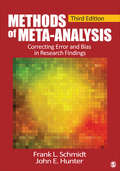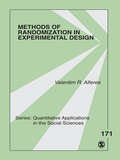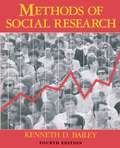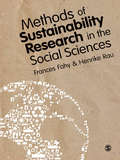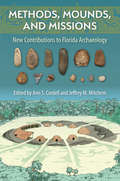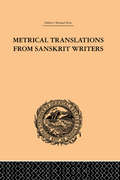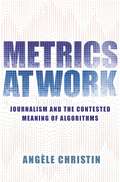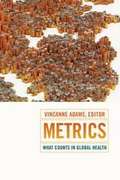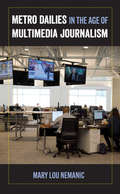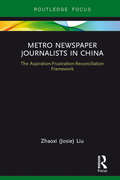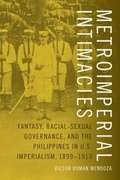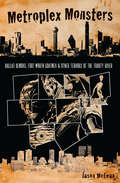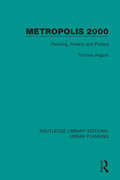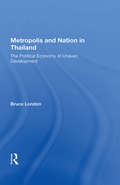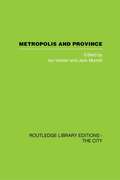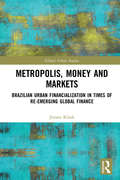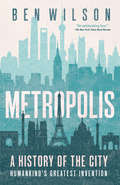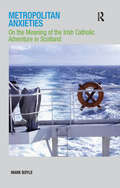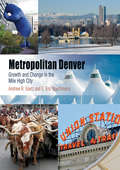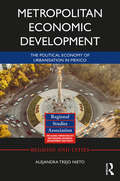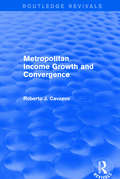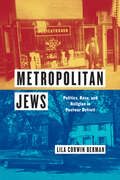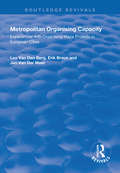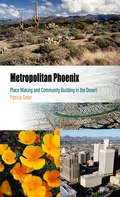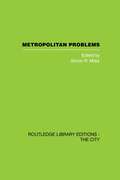- Table View
- List View
Methods of Meta-Analysis: Correcting Error and Bias in Research Findings
by Dr Frank L. Schmidt John E. HunterDesigned to provide researchers clear and informative insight into techniques of meta-analysis, the Third Edition of Methods of Meta-Analysis: Correcting Error and Bias in Research Findings is the most comprehensive text on meta-analysis available today. It is the only book that presents a full and usable treatment of the role of study artifacts in distorting study results, as well as methods for correcting results for such biases and errors. Meta-analysis is arguably the most important methodological innovation in the last thirty-five years, due to its immense impact on the development of cumulative knowledge and professional practice. This text, now in its updated Third Edition, has been revised to cover the newest developments in meta-analysis methods, evaluation, correction, and more. This reader-friendly book is the definitive resource on meta-analysis. “This text is the primary source text for psychometric meta-analysis methods.” —Emily E. Tanner-Smith, Vanderbilt University “The key strength of the book is the complete and thorough coverage of psychometric meta-analysis. This technique is not covered in any other meta-analysis text, and is a major contribution to the literature…The meta-analysis field needs to find ways to integrate Hunter and Schmidt’s methods into current meta-analysis practice.” —Terri D. Pigott, Loyola University of Chicago “This is an important text. It is the only book that presents adequate coverage of psychometric meta-analysis. In addition to its use as a textbook, it is an invaluable resource for anyone involved in meta-analytic studies.” —Steven Pulos, University of Northern Colorado
Methods of Randomization in Experimental Design (Quantitative Applications in the Social Sciences)
by Valentim R. AlferesIn Methods of Randomization in Experimental Design, author Valentim R. Alferes presents the main procedures of random assignment and local control in between-subjects experimental designs and the counterbalancing schemes in within-subjects or cross-over experimental designs. Alferes uses a pedagogical strategy that allows the reader to implement all randomization methods by relying on the materials given in the appendices and using common features included in most word processor software.A companion website provides downloadable IBM SPSS and R versions of SCRAED, a package that performs simple and complex random assignment in experimental design, including the 18 randomization methods presented in Chapters 2 and 3.
Methods of Social Research, 4th Edition
by Kenneth BaileyAn introduction for undergraduates to every stage of sociological research, showing how to deal effectively with typical problems they might encounter. The book is fully updated to include examples from the LA riots and the 1992 presidential elections.
Methods of Sustainability Research in the Social Sciences
by Frances Fahy Henrike RauSustainability is a key concept used by social scientists interested in interactions between human society and the environment. This text offers a systematic and critical review of established and emerging methodological approaches, as well as tools for the integrated investigation of sustainability questions. Recognising the significance of scale for sustainability efforts and measurement, its scope ranges from the local to the global. Divided into five sections: Part I: examines the key challenges inherent to social scientific sustainability research, focusing in particular on methodological questions that arise from recent efforts towards greater disciplinary integration. Part II: discusses methodologies aimed at the investigation of attitudes and behaviour observable at the local level - from families and households to individual organisations within communities. Part III: focuses on comparative sustainability research across different levels of socio-political organisation - from cities and regions to nation-states. Part IV: covers recent developments which recognise the significance of time for sustainability research and which offer innovative methodological approaches that focus on life events and long-term outcome. Part V: offers a critical assessment of current and future trends in social-scientific sustainability researc. Bringing together contributions from international social scientists, this is the resource for academics and practitioners interested in sustainability research. It will be a core teaching text for undergraduate and postgraduate courses in sustainability and sustainable development, geography, environmental sociology and the environmental sciences.
Methods, Mounds, and Missions: New Contributions to Florida Archaeology (Florida Museum of Natural History: Ripley P. Bullen Series)
by Ann S. Cordell and Jeffrey M. MitchemMethods, Mounds, and Missions offers innovative ways of looking at existing data, as well as compelling new information, about Florida’s past. Diverse in scale, topic, time, and region, the volume’s contributions span the late Archaic through historic periods and cover much of the state’s panhandle and peninsula, with forays into the larger Southeast and circum-Caribbean area. Subjects explored in this volume include coastal ring middens, chiefly power and social interaction in mound-building societies, pottery design and production, faunal evidence of mollusk harvesting, missions and missionaries, European iron celts or chisels, Hernando de Soto’s sixteenth-century expedition, and an early nineteenth-century Seminole settlement. The essays incorporate previously underexplored markers of culture histories such as clay sources and non-chert lithic tools and address complex issues such as the entanglement of utilitarian artifacts with sociocultural and ritual realms. Experts in their topical specializations, this volume’s contributors build on the research methods and interpretive approaches of influential anthropologist Jerald Milanich. They update current archaeological interpretations of Florida history, developing and demonstrating the use of new and improved tools to answer broader and larger questions. A volume in the Florida Museum of Natural History: Ripley P. Bullen Series
Metrical Translations from Sanskrit Writers: With An Introduction, Prose Versions, And Parallel Passages From Classical Authors (classic Reprint)
by J. MuirFirst published in 2000. This title is Volume VIII in the XIV-Volume set titled India: Language and Literature, part of Truber's Oriental Series. This volume embraces the contents of the little work entitled Religious and Moral Sentiments, metrically rendered from Sanskrit Writers and presents with a detailed, line-by-line contents, appendix containing prose translations and index. Biblical texts are separated from Sanskrit texts in this index while including classical quotations and parallel passage supplements.
Metrics at Work: Journalism and the Contested Meaning of Algorithms
by Angele ChristinThe starkly different ways that American and French online news companies respond to audience analytics and what this means for the future of newsWhen the news moved online, journalists suddenly learned what their audiences actually liked, through algorithmic technologies that scrutinize web traffic and activity. Has this advent of audience metrics changed journalists’ work practices and professional identities? In Metrics at Work, Angèle Christin documents the ways that journalists grapple with audience data in the form of clicks, and analyzes how new forms of clickbait journalism travel across national borders.Drawing on four years of fieldwork in web newsrooms in the United States and France, including more than one hundred interviews with journalists, Christin reveals many similarities among the media groups examined—their editorial goals, technological tools, and even office furniture. Yet she uncovers crucial and paradoxical differences in how American and French journalists understand audience analytics and how these affect the news produced in each country. American journalists routinely disregard traffic numbers and primarily rely on the opinion of their peers to define journalistic quality. Meanwhile, French journalists fixate on internet traffic and view these numbers as a sign of their resonance in the public sphere. Christin offers cultural and historical explanations for these disparities, arguing that distinct journalistic traditions structure how journalists make sense of digital measurements in the two countries.Contrary to the popular belief that analytics and algorithms are globally homogenizing forces, Metrics at Work shows that computational technologies can have surprisingly divergent ramifications for work and organizations worldwide.
Metrics: What Counts in Global Health
by Vincanne AdamsThis volume's contributors evaluate the accomplishments, limits, and consequences of using quantitative metrics in global health. Whether analyzing maternal mortality rates, the relationships between political goals and metrics data, or the links between health outcomes and a program's fiscal support, the contributors question the ability of metrics to solve global health problems. They capture a moment when global health scholars and practitioners must evaluate the potential effectiveness and pitfalls of different metrics--even as they remain elusive and problematic. Contributors. Vincanne Adams, Susan Erikson, Molly Hales, Pierre Minn, Adeola Oni-Orisan, Carolyn Smith-Morris, Marlee Tichenor, Lily Walkover, Claire L. Wendland
Metro Dailies in the Age of Multimedia Journalism
by Mary Lou NemanicThe death of the daily newspaper in the internet age has been predicted for decades. While print newspapers are struggling from drops in advertising and circulation, their survival has been based on original reporting. Instead of a death knell, metro dailies are experiencing an identity crisis—a clash between traditional print journalism’s formality and detail and digital journalism’s informality and brevity. In Metro Dailies in the Age of Multimedia Journalism, Mary Lou Nemanic provides in-depth case studies of five mid-size city newspapers to show how these publications are adapting to the transition from print-only to multiplatform content delivery—and how newsroom practices are evolving to address this change. She considers the successes when owners allow journalists to manage their newspapers—to ensure production of quality journalism under the protection of newspaper guilds—as well as how layoffs and resource cutbacks have jeopardized quality standards. Arguing for an integrated approach in which print and online reporting are considered complementary and visual journalism is emphasized across platforms, Nemanic suggests that there is a future for the endangered daily metro newspaper.
Metro Newspaper Journalists in China: The Aspiration-Frustration-Reconciliation Framework (Routledge Focus on Journalism Studies)
by Zhaoxi (Josie) LiuThis book explores how journalists at local metro papers in a south-western China metropolis give meaning to their work and how these meanings are shaped by the specific social environment within which these journalists operate. These metro papers provide the bulk of daily news to the general public in China, yet are often understudied compared to the country’s party news outlets. Informed by fieldwork in four metro newspapers, the book puts forward a grounded theory for exploring journalists’ occupational culture: the aspiration-frustration-reconciliation framework.
Metroimperial Intimacies: Fantasy, Racial-Sexual Governance, and the Philippines in U.S. Imperialism, 1899-1913
by Victor Román MendozaIn Metroimperial Intimacies Victor Román Mendoza combines historical, literary, and archival analysis with queer-of-color critique to show how U.S. imperial incursions into the Philippines enabled the growth of unprecedented social and sexual intimacies between native Philippine and U.S. subjects. The real and imagined intimacies--whether expressed through friendship, love, or eroticism--threatened U.S. gender and sexuality norms. To codify U.S. heteronormative behavior, the colonial government prohibited anything loosely defined as perverse, which along with popular representations of Filipinos, regulated colonial subjects and depicted them as sexually available, diseased, and degenerate. Mendoza analyzes laws, military records, the writing of Philippine students in the United States, and popular representations of Philippine colonial subjects to show how their lives, bodies, and desires became the very battleground for the consolidation of repressive legal, economic, and political institutions and practices of the U.S. colonial state. By highlighting the importance of racial and gendered violence in maintaining control at home and abroad, Mendoza demonstrates that studies of U.S. sexuality must take into account the reach and impact of U.S. imperialism.
Metroplex Monsters: Dallas Demons, Fort Worth Goatmen & Other Terrors of the Trinity River
by Jason McLeanIn the metropolitan mosaic that joins Dallas and Fort Worth together into a brightly lit metroplex, some mysterious figures still manage to keep to the shadows and slip through the cracks. Even after the Lake Worth Monster inspired a rash of phone calls to the Fort Worth Police Department, the "Goatman of Greer Island" faded back into the haze of myth. Is Lake Granbury's Ol' One Eye an impossibly large catfish or a sidetracked sea serpent? Could pterosaurs really coexist with the region's congested skies? From the Lady of White Rock Lake to the Creature of Copper Canyon and the Chupacabras of Cedar Hill, Jason McLean methodically follows inexplicable events to their source and bizarre beasts to their lairs.
Metropolis 2000: Planning, Poverty and Politics (Routledge Library Editions: Urban Planning #2)
by Thomas AngottiOriginally published in 1993, Metropolis 2000 analyses 20th century metropolitan development and planning under the economic and environmental conditions of the world’s regions. Attempts to achieve the physical integration of the city without economic equality have failed. The book advances the principle of ‘integrated diversity’ which emphasises linking neighbourhood planning with a broader vision of the planned metropolis and applies a political economy approach, and argues for a new form of pro-urban thinking. The book argues that the basis for a humane approach to city planning is viewing the metropolis as a beneficial accompaniment to national independence, equality and social progress.
Metropolis And Nation In Thailand: The Political Economy Of Uneven Development
by Bruce LondonThis qualitative study of the relationships between one primate city, Bangkok, and its hinterland, the Thai nation, breaks new ground in general sociological theory, redirects the study of city-hinterland relationships, and presents an interpretation of Thai political history that departs significantly from conventional analyses. Professor London f
Metropolis and Province: Science in British Culture, 1780 - 1850
by Ian Inkster Jack MorrellThis collection of case studies, focusing on British scientific culture during the first industrial revolution, explores the social basis of science in the period and asks why such an extraordinarily rich variety of cultural-scientific experience should have flourished at the time. The book analyses science and scientific culture in their local contexts, both metropolitan and provincial, examining where possibel the relations between the two, and emphasizing the range of scientific associations in London, to individual savants in the provinces. This book was first published in 1983.
Metropolis, Money and Markets: Brazilian Urban Financialization in Times of Re-emerging Global Finance (Global Urban Studies)
by Jeroen KlinkThis book explores the impact of finance on urban spaces as well as cities' role in the social constitution and dissemination of financial logistics and techniques. It brings together literature from different disciplinary areas to increase our understanding of financialization. It observes how non-financial members of society, such as public bureaucrats, urban planners, the media and so on, are actively involved in the financialization of urban areas. With an explicit focus on Brazil, a developing country in the Global South, the book demonstrates how the country has been grappling with complex and contradictory processes of neoliberalization, decentralization, re-democratization and institutional-legal strengthening of frameworks for urban and regional planning, stressing the relations between urban space and finance capital. With a distinct view of filling a gap in the current literature on urban financialization, the book aims to focus on less developed areas in this field and link them with the literature on social studies of finance. This makes the text relevant for academics and scholars of urban studies and planning theory, geography, development studies and political economy, as well as scholars in the US and Europe interested in understanding Brazilian patterns of financialization.
Metropolis: A History of the City, Humankind's Greatest Invention
by Ben WilsonFrom a brilliant young historian, a colourful journey through 7,000 years and twenty-six world cities that shows how urban living has been the spur and incubator to humankind's greatest innovations.In the two hundred millennia of our existence, nothing has shaped us more profoundly than the city. Ben Wilson, author of bestselling and award-winning books on British history, now tells the grand, glorious story of how city living has allowed human culture to flourish. Beginning in 5,000 BC with Uruk, the world's first city, immortalized in The Epic of Gilgamesh, he shows us that cities were never a necessity, but that once they existed, their density created such a blossoming of human endeavour--producing new professions, art forms, worship and trade--that they kickstarted civilization itself.Guiding readers through famous cities over 7,000 years, Wilson reveals the innovations driven by each: civics in the agora of Athens, global trade in 9th century Baghdad, finance in the coffeehouses of London, domestic comforts inthe heart of Amsterdam, peacocking in Belle Epoque Paris. In the modern age, he studies the impact of verticality in New York City, the sprawl of LA and the eco-reimagining of 21st-century Shanghai.Lively, erudite, page-turning and irresistible, Metropolis is a grand tour of human endeavour.
Metropolitan Anxieties: On the Meaning of the Irish Catholic Adventure in Scotland
by Mark BoyleIn a lecture entitled ’Scotland’s shame’, delivered at the Edinburgh Festival in August 1999, Scotland’s leading musical composer James MacMillan sought in an explosive way to expose the continuing pervasiveness of anti-Irish and anti-Catholic sectarianism and bigotry in contemporary Scotland. A decade of heated public debate has followed. Drawing upon post-colonial critiques of the provincial nature of metropolitan theory, this book approaches the Scotland's shame debate as, in many ways, itself a classic metrocentric cultural struggle over the true and essential telos of a once colonised population. It argues that the most interesting question the debate has provoked, a question which thus far has failed to generate a worthy answer, is: is the Irish Catholic encounter with Scotland intelligible and if so, what is the nature of this intelligibility? The purpose of this book is to harness the complex and rich theory of colonialism which French philosopher, political activist and novelist Jean-Paul Sartre developed and struggled over, to venture a qualified and partial interpretation of the Irish Catholic experience of Scotland. Nevertheless, in so doing, the book takes seriously the charge of metrocentricism as it bears on the search for the meaning of the Irish Catholic adventure in Scotland and refuses to permit any simplistic interpretation of this adventure. Presenting findings from a new oral history archive consisting of 67 interviews with members of the Irish Catholic community in Scotland, attention is given to the themes of national identity, estrangement and belonging; diasporic imaginings of Ireland; anti-imperial activism, agitation and advocacy; culture, faith and family; and poverty, work education and equality.
Metropolitan Denver: Growth and Change in the Mile High City (Metropolitan Portraits)
by Andrew R. Goetz E. Eric BoschmannNestled between the Rocky Mountains to the west and the High Plains to the east, Denver, Colorado, is nicknamed the Mile High City because its official elevation is exactly one mile above sea level. Over the past ten years, it has also been one of the country's fastest-growing metropolitan areas. In Denver's early days, its geographic proximity to the mineral-rich mountains attracted miners, and gold and silver booms and busts played a large role in its economic success. Today, its central location—between the west and east coasts and between major cities of the Midwest—makes it a key node for the distribution of goods and services as well as an optimal site for federal agencies and telecommunications companies.In Metropolitan Denver, Andrew R. Goetz and E. Eric Boschmann show how the city evolved from its origins as a mining town into a cosmopolitan metropolis. They chart the foundations of Denver's recent economic development—from mining and agriculture to energy, defense, and technology—and examine the challenges engendered by a postwar population explosion that led to increasing income inequality and rapid growth in the number of Latino residents. Highlighting the risks and rewards of regional collaboration in municipal governance, Goetz and Boschmann recount public works projects such as the construction of the Denver International Airport and explore the smart growth movement that shifted development from postwar low-density, automobile-based, suburban and exurban sprawl to higher-density, mixed use, transit-oriented urban centers.Because of its proximity to the mountains and generally sunny weather, Denver has a reputation as a very active, outdoor-oriented city and a desirable place to live and work. Metropolitan Denver reveals the purposeful civic decisions made regarding tourism, downtown urban revitalization, and cultural-led economic development that make the city a destination.
Metropolitan Economic Development: The Political Economy of Urbanisation in Mexico (Regions and Cities)
by Alejandra Trejo NietoMetropolitan areas are home to a significant proportion of the world’s population and its economic output. Taking Mexico as a case study and weaving in comparisons from Latin America and developed countries, this book explores current trends and policy issues around urbanisation, metropolisation, economic development and city-region governance. Despite their fundamental economic relevance, the analysis and monitoring of metropolitan economies in Mexico and other countries in the Global South under a comparative perspective are relatively scarce. This volume contains empirical analysis based on comparative perspectives with relation to international experiences. It will be of interest to advanced students, researchers and policymakers in urban policy, urban economics, regional studies, economic geography and Latin American studies.
Metropolitan Income Growth and Convergence (Routledge Revivals Ser.)
by Roberto J. CavazosThis title was first published in 2001. What determines urban growth? Much has been written on particular causes and incidents which can explain the rise of one metropolis and the fall of another, but these do not illustrate general tendencies. This volume asks whether theories used to explain economic growth of nations or regions can be employed to find characteristics which encourage the growth of cities. Cavazos tests two principal theoretical approaches in this way. The first, the endogenous growth theory, predicts that incomes will diverge and sees technological innovations as the engine of economic growth. The second, the neoclassical growth theory, predicts conditional convergence and rates capital accumulation as the key to economic growth. He uses the two models to study US metropolitan income growth between 1970 and 1990 and compares their performance to determine which provides more insightful explanations of metropolitan growth.
Metropolitan Jews: Politics, Race, and Religion in Postwar Detroit (Historical Studies of Urban America)
by Lila Corwin BermanIn this provocative and accessible urban history, Lila Corwin Berman considers the role that Detroit's Jews played in the city's well-known narrative of migration and decline. Taking its cue from social critics and historians who have long looked toward Detroit to understand twentieth-century urban transformations, Metropolitan Jews tells the story of Jews leaving the city while retaining a deep connection to it. Berman argues convincingly that though most Jews moved to the suburbs, urban abandonment, disinvestment, and an embrace of conservatism did not invariably accompany their moves. Instead, the Jewish postwar migration was marked by an enduring commitment to a newly fashioned urbanism with a vision of self, community, and society that persisted well beyond city limits. Complex and subtle, Metropolitan Jews pushes urban scholarship beyond the tenacious black/white, urban/suburban dichotomy. It demands a more nuanced understanding of the process and politics of suburbanization and will reframe how we think about the American urban experiment and modern Jewish history.
Metropolitan Organising Capacity: Experiences with Organising Major Projects in European Cities (Routledge Revivals)
by Erik Braun Leo van Berg Jan van MeerPublished in 1997. The environment of cities has become increasingly competitive. Tradition location factors, that once tied economic activities firmly to particular areas have become less important. Increasingly the ability of a city to anticipate, respond to and cope with internal and external changes is getting attention. Organizing capacity of cities, or of metropolitan regions is becoming indispensible for sustainable economic and social development. The authors have carried out investigations into eight European cities to increase the insight into the practice of organizing capacity. The analysis of the development and implementation of 15 revitalization projects in these cities shows that organizing capacity calls for a new style of entrepreneurial urban management with public and private networking, leadership, long term strategies and organizing political and public support as key concepts.
Metropolitan Phoenix
by Patricia GoberInhabitants of Phoenix tend to think small but live big. They feel connected to individual neighborhoods and communities but drive farther to get to work, feel the effects of the regional heat island, and depend in part for their water on snow packs in Wyoming. In Metropolitan Phoenix, Patricia Gober explores the efforts to build a sustainable desert city in the face of environmental uncertainty, rapid growth, and increasing social diversity.Metropolitan Phoenix chronicles the burgeoning of this desert community, including the audacious decisions that created a metropolis of 3.6 million people in a harsh and demanding physical setting. From the prehistoric Hohokam, who constructed a thousand miles of irrigation canals, to the Euro-American farmers, who converted the dryland river valley into an agricultural paradise at the end of the nineteenth century, Gober stresses the sense of beginning again and building anew that has been deeply embedded in wave after wave of human migration to the region. In the early twentieth century, the so-called health seekers--asthmatics, arthritis and tuberculosis sufferers--arrived with the hope of leading more vigorous lives in the warm desert climate, while the postwar period drew veterans and their families to the region to work in emerging electronics and defense industries. Most recently, a new generation of elderly, seeking "active retirement," has settled into planned retirement communities on the perimeter of the city.Metropolitan Phoenix also tackles the future of the city. The passage of a recent transportation initiative, efforts to create a biotechnology incubator, and growing publicity about water shortages and school funding have placed Phoenix at a crossroads, forcing its citizens to grapple with the issues of social equity, environmental quality, and economic security. Gober argues that given Phoenix's dramatic population growth and enormous capacity for change, it can become a prototype for twenty-first-century urbanization, reconnecting with its desert setting and building a multifaceted sense of identity that encompasses the entire metropolitan community.
Metropolitan Problems
by S. MilesMetropolitan Problems is the end-product of one of the most dynamic research programmes of its kind ever conceived and executed. The book, which took three years to complete, represents the culmination of a two year study that was highlighted by a conference held in toronto in 1967. In the early 1960s, the bureau of Municipal Research (in metropolitan Toronto) decided that a significant way for it to celebrate Canada's centennial would be to initiate a systematic international study of the world's metropolitan areas. The study, with the official cooperation of the United Nations, was designed to produce positive insights into the methods of coping with the interlocking sets of problems associated with the expansion of the modern metropolis. Twelve papers on various aspects of metropolitan problems were commissioned from an international body of experts. Working with these experts were study groups drawn from forty major metropolitan centres throughout the world. After making exhaustive studies of their respective urban centres, the groups reported their findings and submitted detailed briefs through their representatives at the conference. Throughout the symposium, a conscious effort was made to examine single aspects of social, economic and physical change within the overall perspective of the metropolis. The book reflects this approach. Each chapter directs attention to specific problems of the metropolis, problems resulting from the contradiction between accelerating technology and our ability to cope with the incredible pace and rate of change. Together they prove that, despite differences in technology, culture, and political and social matters, the major urban areas of the world do have much in common. Emerging tendencies can be analysed and corrective and preventative measures be made through comparative analysis. This book was first published in 1970.
